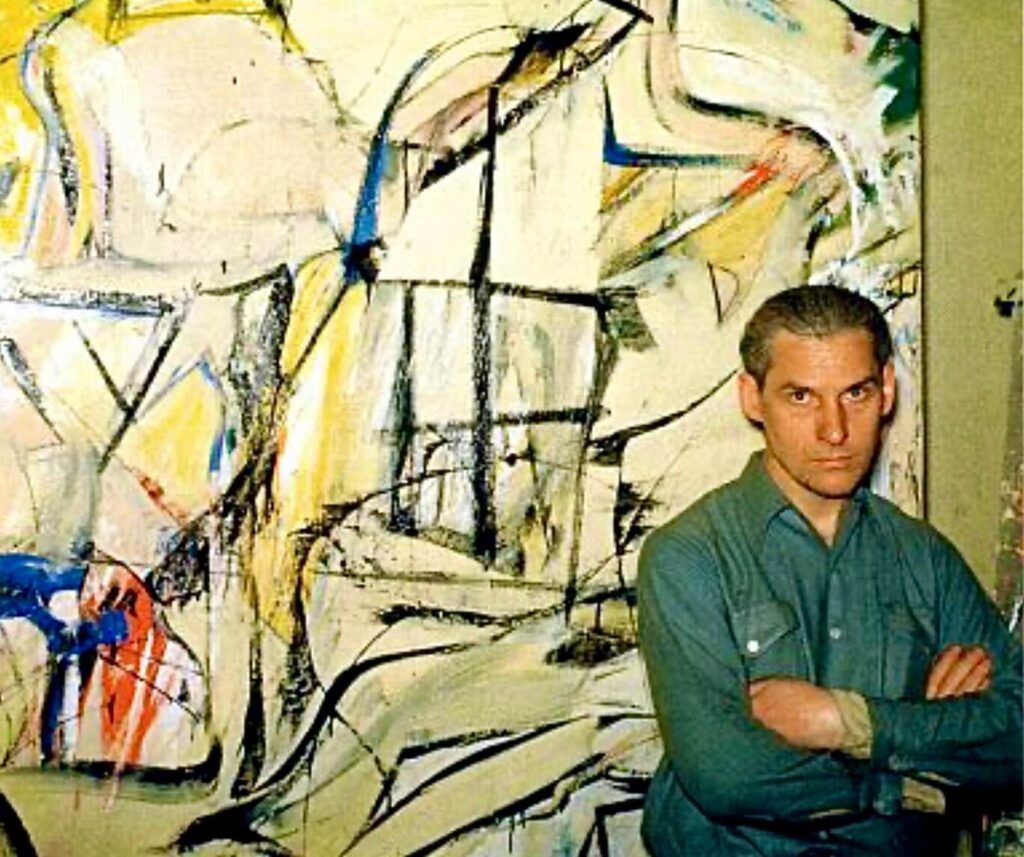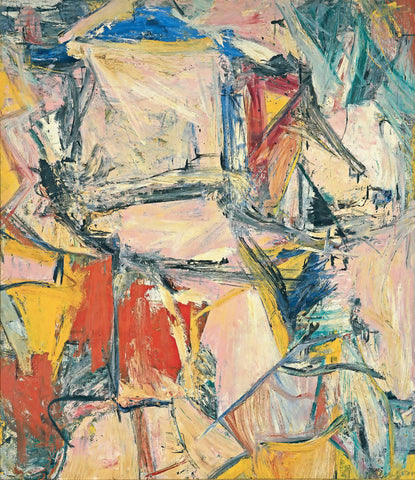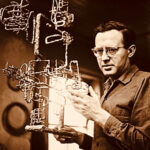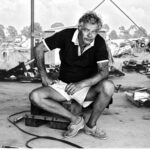Willem de Kooning
Willem de Kooning, a Dutch-American painter and a leading figure in the Abstract Expressionist movement, is celebrated for his powerful, emotive works that blend abstraction and figuration. His dynamic brushwork, innovative techniques, and profound exploration of the human figure have made him one of the most influential artists of the 20th century.

Early Life and Artistic Development
Willem de Kooning was born on April 24, 1904, in Rotterdam, Netherlands. His early years were marked by hardship, including his parents’ separation and financial struggles. Despite these challenges, de Kooning showed a talent for art from a young age and began an apprenticeship in commercial design at the age of 12. This training provided him with a strong foundation in drawing and composition.
In 1926, de Kooning stowed away on a ship bound for the United States, arriving in New York City. He initially worked as a house painter and commercial artist while continuing to develop his artistic skills. De Kooning’s early work was influenced by the European avant-garde movements of Cubism and Surrealism, as well as the American Social Realism of the 1930s.
Transition to Abstract Expressionism
By the late 1930s, de Kooning had become associated with a group of artists who would later form the core of the Abstract Expressionist movement, including Jackson Pollock, Franz Kline, and Mark Rothko. During this period, de Kooning began to move away from representational art, experimenting with abstraction and the expressive potential of paint.
In the 1940s, de Kooning developed a unique style characterized by bold, gestural brushwork and a dynamic interplay of forms. His work from this period often featured abstracted figures and landscapes, reflecting his interest in the tension between abstraction and representation.
Notable Works
1. “Excavation” (1950)
“Excavation” is considered one of de Kooning’s masterpieces and a defining work of Abstract Expressionism. The painting is a large, complex composition filled with interlocking shapes and vibrant colors. The title suggests a process of digging or uncovering, reflecting de Kooning’s interest in the act of painting as a form of exploration.
The work’s dense, layered surface invites viewers to look closely and uncover hidden forms and figures. “Excavation” exemplifies de Kooning’s ability to balance chaos and order, creating a composition that is both dynamic and cohesive.

2. “Woman I” (1950-1952)
“Woman I” is part of a series of paintings of women that de Kooning worked on throughout the 1950s. This series marked a significant departure from his earlier, more abstract works, as it reintroduced the human figure in a bold, confrontational manner. “Woman I” is characterized by its aggressive brushwork, vivid colors, and exaggerated features, blending abstraction and figuration.
The painting sparked controversy and divided critics, with some viewing it as a misogynistic portrayal of women and others seeing it as a powerful exploration of the female form. Regardless of interpretation, “Woman I” is a testament to de Kooning’s ability to provoke and challenge viewers, pushing the boundaries of traditional representation.

3. “Interchange” (1955)
“Interchange” is another pivotal work in de Kooning’s oeuvre, notable for its vibrant color palette and fluid, gestural brushstrokes. The painting captures the dynamic energy and movement that are hallmarks of de Kooning’s style, with abstract forms that suggest figures and landscapes in constant flux.
The composition is marked by a sense of spontaneity and immediacy, reflecting de Kooning’s belief in the importance of the painting process itself. “Interchange” exemplifies his ability to create a sense of depth and complexity through the interplay of color and form, making it one of his most celebrated works.

Techniques and Innovations
Willem de Kooning’s innovative techniques and approaches to painting were integral to his success and influence. He often worked on multiple paintings simultaneously, allowing ideas and techniques to flow between works. De Kooning’s method of scraping and reworking the paint surface created a sense of depth and texture, giving his compositions a tactile quality.
His use of color was also groundbreaking. De Kooning often mixed vibrant, contrasting hues directly on the canvas, creating a dynamic interplay of color that added to the emotional intensity of his work. His brushwork was characterized by bold, sweeping gestures that conveyed a sense of movement and energy, capturing the physical act of painting.
Influence and Legacy
Willem de Kooning’s impact on the art world extends far beyond his own body of work. As a leading figure in Abstract Expressionism, he helped to establish New York City as the center of the art world in the mid-20th century, shifting the focus away from Europe. His innovative techniques and bold approach to painting influenced a generation of artists and continue to inspire contemporary artists today.
De Kooning’s exploration of the human figure within an abstract context opened new possibilities for representation in art. His willingness to blend abstraction and figuration challenged traditional boundaries and paved the way for future artists to experiment with form and content.
Personal Life and Challenges
De Kooning’s personal life was marked by both triumphs and struggles. He married painter Elaine Fried in 1943, and their relationship was both collaborative and tumultuous. Elaine de Kooning was a significant influence on Willem’s work, and she played a crucial role in promoting his career. However, their marriage was also marked by infidelity and periods of separation.
Like many of his contemporaries, de Kooning struggled with alcoholism, which affected both his personal life and his work. Despite these challenges, he continued to create groundbreaking art throughout his career, constantly evolving and pushing the boundaries of his practice.
Later Years and Continued Evolution
In the 1960s and 1970s, de Kooning’s work underwent significant changes. He moved away from the aggressive brushwork and intense colors of his earlier work, embracing a more lyrical and fluid style. His compositions became more open and airy, often featuring lighter colors and more simplified forms.
During this period, de Kooning also explored sculpture, creating dynamic, abstract forms that reflected his interest in movement and fluidity. His late paintings and sculptures are characterized by a sense of tranquility and grace, demonstrating his continued evolution as an artist.
Recognition and Legacy
Willem de Kooning’s contributions to art were widely recognized during his lifetime and have continued to be celebrated posthumously. He received numerous awards and honors, including the Presidential Medal of Freedom in 1964. Major retrospectives of his work have been held at prestigious institutions such as the Museum of Modern Art in New York and the National Gallery of Art in Washington, D.C.
De Kooning’s legacy is evident in the continued influence of his work on contemporary artists. His bold, gestural brushwork and innovative techniques have inspired countless artists to explore the expressive potential of paint and the dynamic interplay of form and color.
Conclusion
Willem de Kooning was a master of Abstract Expressionism, whose innovative techniques and profound exploration of the human figure redefined the boundaries of modern art. Through his most notable works, such as “Excavation,” “Woman I,” and “Interchange,” de Kooning challenged traditional notions of representation and abstraction, creating a powerful and enduring body of work. His influence on the art world is immeasurable, and his legacy continues to inspire and challenge artists today.



